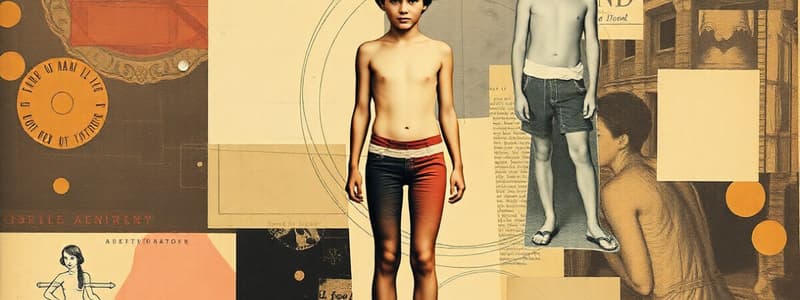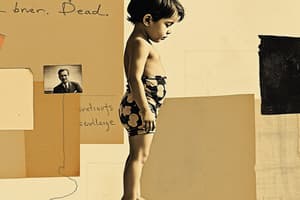Podcast
Questions and Answers
What determines the sex and physical traits of an offspring during fertilization?
What determines the sex and physical traits of an offspring during fertilization?
- The combination of chromosomes and genes (correct)
- Environmental factors after birth
- The mother's health and nutrition
- The father's personality traits
Which type of chromosomes are responsible for carrying traits other than sex in humans?
Which type of chromosomes are responsible for carrying traits other than sex in humans?
- Autosomes (correct)
- Y-linked chromosomes
- Gonosomes
- Mitochondrial chromosomes
How are recessive genes expressed in comparison to dominant genes?
How are recessive genes expressed in comparison to dominant genes?
- Recessive genes are masked when dominant genes are present. (correct)
- Recessive genes are always expressed regardless of dominant genes.
- Recessive genes are dominant when paired with another recessive gene.
- Recessive genes influence traits equally with dominant genes.
Which of the following is NOT a factor of environment affecting physical development?
Which of the following is NOT a factor of environment affecting physical development?
What is 'body image' primarily concerned with?
What is 'body image' primarily concerned with?
During which stage of life does physical efficiency generally peak?
During which stage of life does physical efficiency generally peak?
What is one characteristic of the adolescence stage?
What is one characteristic of the adolescence stage?
Which stage of the life span occurs from fertilization to birth?
Which stage of the life span occurs from fertilization to birth?
At what stage of life does the body perform its functions least well?
At what stage of life does the body perform its functions least well?
What primarily concerns health during the prenatal stage?
What primarily concerns health during the prenatal stage?
What is a major focus of early childhood development?
What is a major focus of early childhood development?
How does physical growth during childhood compare to that in babyhood?
How does physical growth during childhood compare to that in babyhood?
Which factor significantly affects physical development of the self?
Which factor significantly affects physical development of the self?
At what stage does puberty typically occur?
At what stage does puberty typically occur?
What is a defining feature of physical self?
What is a defining feature of physical self?
What is a common experience during middle adulthood?
What is a common experience during middle adulthood?
Which developmental stage emphasizes acquiring social skills through play?
Which developmental stage emphasizes acquiring social skills through play?
What do socio-biologists typically argue in the nature versus nurture debate?
What do socio-biologists typically argue in the nature versus nurture debate?
During adolescence, what is a critical challenge faced by teens?
During adolescence, what is a critical challenge faced by teens?
What factors are significant in the late adulthood stage of life?
What factors are significant in the late adulthood stage of life?
What illustrates a key developmental shift during early adulthood?
What illustrates a key developmental shift during early adulthood?
What is one common effect of poor body image?
What is one common effect of poor body image?
Which eating disorder is associated with an unhealthy focus on weight loss?
Which eating disorder is associated with an unhealthy focus on weight loss?
How do cultural values influence standards of beauty?
How do cultural values influence standards of beauty?
What impact does poor body image have on mental health?
What impact does poor body image have on mental health?
What is one way people may attempt to modify their bodies due to poor body image?
What is one way people may attempt to modify their bodies due to poor body image?
What characteristic is often considered a standard of beauty across cultures?
What characteristic is often considered a standard of beauty across cultures?
What does the concept of beauty often imply regarding an individual's health?
What does the concept of beauty often imply regarding an individual's health?
Which period considered women with full figures as beautiful?
Which period considered women with full figures as beautiful?
Flashcards
Physical Self
Physical Self
The body, including its parts (head, neck, arms, legs) and internal organs (brain, heart, etc.), that allows for functions like breathing and movement.
Stages of Life Span
Stages of Life Span
The different phases of development from conception to death, each marked by specific physical, cognitive, and social changes.
Prenatal Stage
Prenatal Stage
The stage from fertilization to birth, where major body structures form.
Infancy
Infancy
Signup and view all the flashcards
Adolescence Stage
Adolescence Stage
Signup and view all the flashcards
Physical Development
Physical Development
Signup and view all the flashcards
Physical efficiency peaks
Physical efficiency peaks
Signup and view all the flashcards
Heredity
Heredity
Signup and view all the flashcards
Chromosomes
Chromosomes
Signup and view all the flashcards
Autosomes
Autosomes
Signup and view all the flashcards
Gonosomes
Gonosomes
Signup and view all the flashcards
Genes
Genes
Signup and view all the flashcards
Dominant Genes
Dominant Genes
Signup and view all the flashcards
Recessive Genes
Recessive Genes
Signup and view all the flashcards
Environment in Growth
Environment in Growth
Signup and view all the flashcards
Body Image
Body Image
Signup and view all the flashcards
Appearance
Appearance
Signup and view all the flashcards
Self-Esteem
Self-Esteem
Signup and view all the flashcards
Poor Body Image Cause
Poor Body Image Cause
Signup and view all the flashcards
Body Dissatisfaction Effect
Body Dissatisfaction Effect
Signup and view all the flashcards
Depression (Body Image)
Depression (Body Image)
Signup and view all the flashcards
Low Self-Esteem (Body Image)
Low Self-Esteem (Body Image)
Signup and view all the flashcards
Eating Disorders (Body Image)
Eating Disorders (Body Image)
Signup and view all the flashcards
Body Modification (Body Image)
Body Modification (Body Image)
Signup and view all the flashcards
Concept of Beauty (Historical)
Concept of Beauty (Historical)
Signup and view all the flashcards
Beauty Standards (Historical)
Beauty Standards (Historical)
Signup and view all the flashcards
Trust and Security
Trust and Security
Signup and view all the flashcards
Babyhood
Babyhood
Signup and view all the flashcards
Early Childhood
Early Childhood
Signup and view all the flashcards
Late Childhood
Late Childhood
Signup and view all the flashcards
Puberty
Puberty
Signup and view all the flashcards
Adolescence
Adolescence
Signup and view all the flashcards
Early Adulthood
Early Adulthood
Signup and view all the flashcards
Middle Adulthood
Middle Adulthood
Signup and view all the flashcards
Late Adulthood
Late Adulthood
Signup and view all the flashcards
Nature vs Nurture
Nature vs Nurture
Signup and view all the flashcards
Study Notes
Unpacking the Self: The Physical Self
- Learning Outcomes:
- Understand life stages and physical changes.
- Identify genetic and environmental factors in physical development.
- Describe factors affecting body image.
- Examine cultural impact on body image and self.
- Develop a positive body image.
Physical Self
- Definition: The physical self encompasses the body, including basic parts (head, neck, arms, legs) and internal organs (brain, heart, lungs, stomach, intestines, muscles).
- Function: Organs work together for functions like breathing, walking, and dancing. Physical abilities change throughout life.
- Development: Physical development is rapid in babyhood but slower during childhood.
- Crucial Stage: Adolescence is a critical period of development.
- Puberty: Physical changes, including reproductive system maturation, occur during puberty.
- Life Span: Development spans from conception to death. Elizabeth Hurlock outlined the stages in a 10-part system.
Stages of Life Span
- Prenatal: From fertilization to birth. Major body structures develop. Mother's health is crucial.
- Infancy: Birth to two weeks. Significant growth, motor skills, language, and attachment develop.
- Babyhood: Two weeks to second year. Physical, cognitive, and emotional growth accelerate as the child interacts more with their environment.
- Early Childhood: Two to six years. Logical thinking, friendships, and academic skills develop through play.
- Late Childhood: Six to 10/12 years. School skills, social interaction, and sense of competence develop.
- Puberty: 10/12 to 14 years. Dramatic physical changes, identity formation, and emotional growth.
- Adolescence: 14 to 18 years. Self-discovery, independence, physical changes, and relationships.
- Early Adulthood: 18 to 40. Intimate relationships, education, and achieving goals.
- Middle Adulthood: 40 to 60. Reflecting on life achievements and potential adjustments.
- Late Adulthood: 60 to death. Retirement, physical aging, and reflecting on life.
Factors Affecting Physical Growth and Development
Heredity
- Biological transmission of traits from parents.
- Sex and physical features are influenced by the combination of chromosomes and genes during fertilization.
- Chromosomes: Threadlike structures carrying genes; typically in pairs (23 pairs in humans).
- Genes: Carriers of hereditary traits; classified as dominant (stronger) or recessive (weaker).
Environment
- Factors affecting development after conception (e.g., diet, nutrition, diseases, learning, experience).
- Diet, nutrition, and disease play a significant role in physical growth.
Body Image
- Definition: How individuals perceive, think, and feel about their body and appearance.
- Appearance: Observable features like height, weight, skin color, clothes, and hairstyle.
- Self-Esteem: Overall evaluation of one's worth.
- Negative Effects: Poor body image can lead to:
- Body dissatisfaction
- Depression (low mood, appetite changes, sleep issues, agitation, difficulty concentrating)
- Low self-esteem
- Eating disorders (bulimia nervosa, anorexia nervosa)
- Body modification (tattoos, permanent makeup, body piercing, cosmetic surgery).
Concept of Beauty
-
Cultural Variations: Beauty standards change over time based on cultural values and historical periods.
- Egyptian art: Slim figures with high waists and narrow hips.
- Renaissance: Full figures with rounded hips were considered beautiful.
- Some African tribes: Chubby, plump, or fat women are beautiful.
- Some tribes in Malaysia, Philippines, and Indonesia: Flat noses are considered attractive.
-
Universal Elements: Some elements are consistently considered beautiful throughout history.
- Clean and unblemished skin.
-
Thick, healthy hair.
-
Well-proportioned bodies.
-
Symmetrical faces.
-
Importance: Beauty has significance in all societies – attractive individuals often have advantages.
Studying That Suits You
Use AI to generate personalized quizzes and flashcards to suit your learning preferences.




